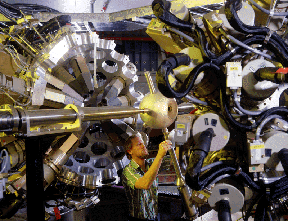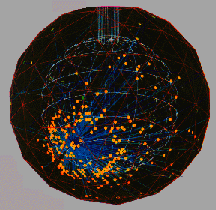
Frontiers in Fundamental Science

The Gammasphere, designed to detect and analyze
gamma
rays, shown during the final phases of its assembly, Fall 1994.


The Gammasphere, designed to detect and analyze
gamma
rays, shown during the final phases of its assembly, Fall 1994.
This past year, LBL scientists played a crucial role in achieving what was hailed as a major milestone for modern physics -- the discovery of evidence for the subatomic particle known as the top quark. The existence of the top quark is required by the Standard Model, the basic theory of particles and forces now invoked to explain virtually all the phenomena of modern physics. This theory holds that there are six quarks, grouped into three distinct pairs, that combine to form larger particles such as the protons and neutrons in the nuclei of atoms. The fifth of these six, called the bottom quark, was discovered in 1977 at Fermi National Accelerator Laboratory's Tevatron accelerator. Scientists have been searching for its partner, the top quark, ever since. An international collaboration of researchers using the Collider Detector at Fermilab (CDF) reported that analysis of high-energy collisions between protons and antiprotons strongly indicated the production of top quarks. The key to this discovery was the 2,000 ton CDF detector, which serves as a giant trap for particles and energy. One group of LBL researchers helped design the Silicon Vertex Detector, an extremely high resolution instrument at the heart of the CDF array that enabled precise quark identification and tracking. Another LBL group analyzed the CDF data to determine the mass of the top quark candidates.
For all that is known about the structure of the atomic nucleus, there are still a number of unexplored areas on this frontier as well. In particular, scientists want to know more about what happens to atomic nuclei under the extreme physical conditions that can exist on earth in accelerators, or in white dwarfs, neutron stars, and other types of exotic objects in the cosmos. This research should receive a big boost from the coming on line this past year of "Gammasphere" at LBL's 88-Inch Cyclotron. Gammasphere is the world's most powerful instrument for detecting gamma rays, a metal sphere containing a honeycomb of high-resolution germanium crystal detectors and bismuth-germanate scintillation counters. This array of devices makes Gammasphere a hundred times more sensitive than previous detectors and will enable scientists from all over the country to study the short-lived (50 trillionths of a second) nuclear states collectively known as "superdeformed nuclei." This phenomenon occurs when a fast-moving beam of ions strikes a target and the nuclei of the projectile and target ions fuse together and go spinning off. The spinning rotation causes the fused nuclei to assume unusual shapes (like footballs or pancakes) then give off gamma rays as they return to normal. Detecting and analyzing these gamma rays yields information about the world inside the atom that scientists could never learn from studying normal nuclei.
LBL is also playing a major role in the design and construction of the world's most powerful detector of neutrinos, the particles emitted from the sun and from supernovas that are so ghostlike they can pass unscathed through a wall of lead as thick as the distance from the earth to the moon. The detector is called the Sudbury Neutrino Observatory (SNO) and it is currently being installed in a cavern more than a mile underground near the Canadian town of Sudbury. SNO is a collaboration involving more than 60 scientists from a dozen laboratories and universities in the United States, Canada, and the United Kingdom. LBL scientists and engineers designed SNO's support frame, an18 meters-in-diameter, 58,000 pound, stainless steel geodesic sphere. They also designed the hexagonal-shaped panel arrays that are attached to the sphere and house 9,522 of extremely sensitive light-detectors called photomultiplier tubes.
 When completed, the SNO detector will be suspended in a vast pool of purified
water. Inside the sphere will be an acrylic vessel filled with 1,000 tons of
heavy water. Neutrinos passing through the heavy water will interact with
deuterium nuclei and emit flashes of light that the photomultiplier tubes will
detect and convert into electronic signals, as depicted in the accompanying simulation.
When completed, the SNO detector will be suspended in a vast pool of purified
water. Inside the sphere will be an acrylic vessel filled with 1,000 tons of
heavy water. Neutrinos passing through the heavy water will interact with
deuterium nuclei and emit flashes of light that the photomultiplier tubes will
detect and convert into electronic signals, as depicted in the accompanying simulation.
Analyzing these signals will enable scientists for the first time ever to measure not only ordinary electron neutrinos, but also the much more rare muon and tau neutrinos. This could answer whether neutrinos have any mass at all (an important issue for cosmology) and also explain a mystery about solar neutrinos that has cast doubts on some aspects of the Standard Model.
What is the age of our universe? It's a puzzle scientists have been trying to solve for many years. For the answer, LBL researchers have turned to what has been billed as "the final frontier"--outer space. This past year, LBL astrophysicists announced the discovery of three of the exploding stars known as "supernovas" that were among the most distant from Earth ever detected. The sightings all took place in a single week--the most ever within such a short period of time--and all were observed using a new technique developed by the LBL researchers over a five-year period to make the discovery of supernovas easier. The three supernovas were located in galaxies approximately 3 to 5 billion light years away, which means they exploded roughly around the time the earth was formed, and all were identified as "Type Ia" which means they were white dwarfs (aging stars about the size of the earth but with the same mass as the sun) that exploded from gravitational pressure. Because Type Ia supernovas always give off about the same amount of light, they can be used to measure distances in space. With the identification of perhaps no more than 50 of these supernovas, scientists believe they can determine whether our universe is finite and will eventually contract, or infinite and will expand forever.

Return to the Table of Contents of the 1994 Regents Report
